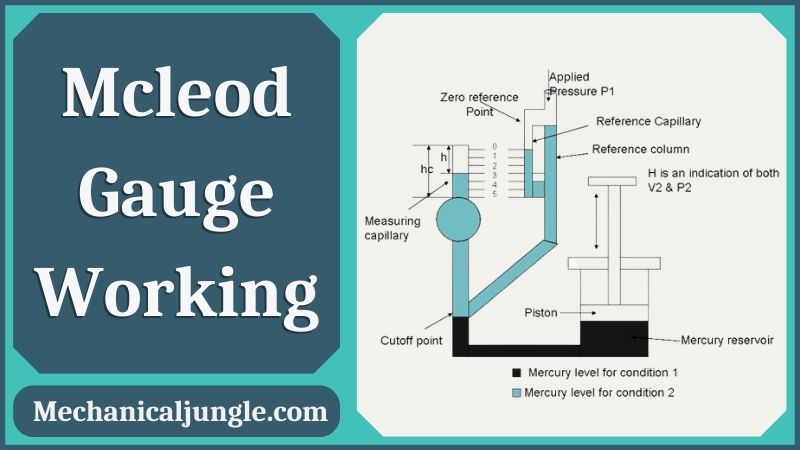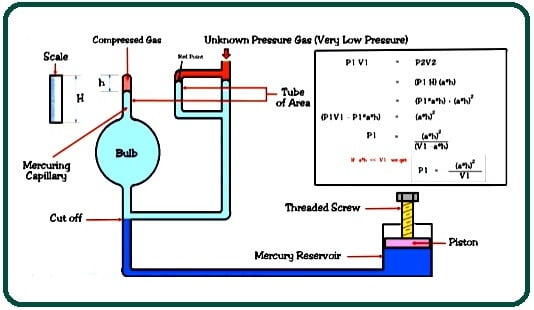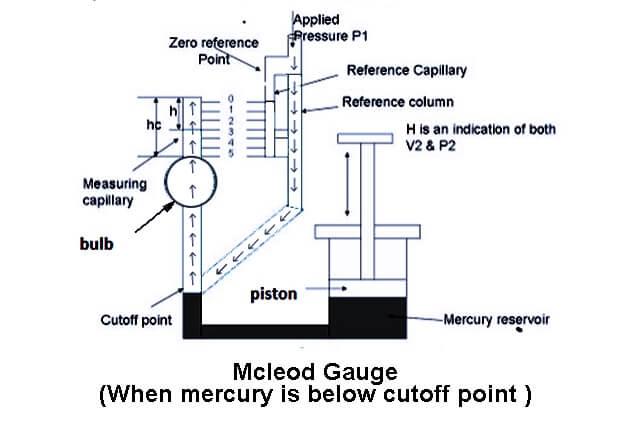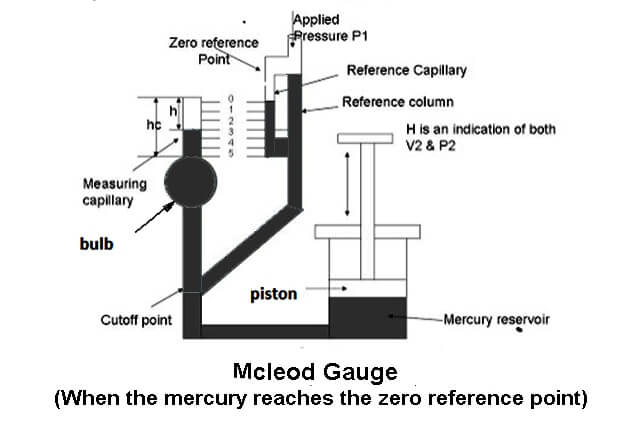
What Is Mcleod Gauge?
A Mcleod gauge is a device used to measure very low pressures at approximately 10-6 torr. The device is named after its inventor, Herbert Mcleod. It was invented by Herbert McLeod in the year 1874.
The size of the mac load gauge is similar to that of a mercury manometer which is the most common instrument used for the measurement of pressure. This Mcleod gauge also has mercury inside it, and the pressure measurement is done by observing changes in the mercury level.
Parts of Mcleod Gauge:

#1. Mercury Reservoir
The Mercury reservoir is used to store mercury which can be used to measure the pressure in the mac load gauge.
#2. Piton
A piston is used to increase or decrease the level of mercury in the measuring capillary, bulb, reference column, and reference capillary.
#3. Reference Column with Reference Capillary
The pressures to be measured are applied to this reference column from above. This reference column is connected with the reference capillary, which has a scale, and the zero reading of this reference capillary is called the zero reference point.
#4. Bulb and Measuring Capillary
It is connected with the bulb and the measurement capillary reference column. The McLeod gauge is designed in such a way that there will be some space left in the measuring capillary when the mercury reaches the zero-degree point.
The point where the measuring capillary and the reference column meet is called the cut-off point. This is called the cut-off point because when the mercury level is raised above this point, the penetration of the applied pressure from the reference column to the measuring capillary and bulb will be cut off.
#5. Scale
The capillary and the reference capillary are common measures for measuring.
Principle of Mcleod Gauge:
The known volume of the gas is compressed into a small volume whose final value provides an indication of the applied pressure. The Mcleod gauge works on the principle of Boyle’s law.
Boyle’s law states that if the temperature and volume of gas remain unchanged, the absolute pressures exerted by a given mass of gas are inversely proportional to its volume.
According to Boyle’s law:
P1V1 = P2V2
Working of Mcleod Gauge:
The Macleod gauge works by taking a sample of the gas from the vacuum chamber and then tilting it and infecting it with mercury. As in this Mcleod gauge, the pressures are calculated using Boyle’s law. Therefore, we must first pressurize a known amount of gas.
So the pressure we want to measure, or the initial pressure (P1), is applied at the top of the reference column. The mercury levels are raised by pressing the piston down.
As the pistons are pressed down, the mercury level in the mercury reservoir decreases, and the level of mercury in the measuring capillary increases.
The level of mercury in measuring capillary is brought just below the cut-off point, & at this point, the applied pressure fills the bulb & capillary.
After the bulb and capillary are filled, the piston operates again, and the mercury level in the gauge rises and reaches the cut-off point. When the mercury level reaches the cut-off point, a known amount of gas is trapped in the bulb and the measuring capillary.
Mcleod gauge is independent of gas composition. If, however, the gas contains condensate material and condenses during compression, the gauge reading is defective. The gauge is not able to read continuously, and the scale is of the class method type.
For linearizing the scale at comparatively higher pressures, a second volume is introduced, as shown in the figure below, where the scale has shown is linear.

After that, the piston is re-driven, and the mercury level is raised further so that the gas trapped in the bulb & the measuring capillary are compressed. The mercury level is raised to a point so that it reaches zero reference point.
 After the compression, the volumes of the gas are again noted, & this volume will be called the final volumes of the gas. These volumes are read directly by the scale.
After the compression, the volumes of the gas are again noted, & this volume will be called the final volumes of the gas. These volumes are read directly by the scale.
The difference in the height of the measuring capillary and the reference capillaries, which is denoted by “h,” is a measure of volume & pressure of the trapped gas.
After this, we know the final volume (V2), final pressure (P2), and we already know the initial volume (V1). From these values, we will find initials pressure (P1) using Boyle’s Law:
Now according to Boyle’s Law:
P1 V1 = P2 V2
Now let us suppose,
The volume of the bulb from the cut-off point to the beginning of the measuring capillary = V
Area of a cross-section of measuring capillary = a
Measuring capillary height = hc
The initial volume of gas which is trapped in the bulb and measuring capillary ( V1 ) = V + ahc
Initial or applied pressures of the gas ( P1 ) = Unknown
When the mercury reaches the zero reference points in the reference capillary, final volume (V2) = ah.
Final pressure ( P2 ) = P1 + h
Now we have the required values of known pressure and volumes. Now we will put these values in the equation of Boyle’s Law.
P1 V1 = P2 V2
P1 V1 = (P1 + h) ah
P1 V1 = P1ah + ah²
P1 V1 – P1ah = ah²
P1 (V1 – ah) = ah²
P1 = ah² / V1 – ah
(Since ‘a’, i.e., a cross-section of measuring capillary is very small, and ‘h’, which is the difference in the height of measuring capillary and the reference capillary, is also very small. So, the product ‘ah’ will also be very small & can be neglected. )
P1 = ah² / V1
So in this way, P1, i.e., the initial pressures, can be measured using Mcleod Gauge.
Limitations of Mcleod Gauge:
- The gas pressure to be measured must follow Boyle’s law
- A moisture trap must be provided to avoid any vapor in the gauge.
- It measures only on a sampling basis.
- It cannot give a continuous output.
Applications of Mcleod Gauge:
- Mcleod gauges are mainly used for the calibration of other inferior types of gauges.
- The drawbacks of the McLeod gauge are its fragility and inability to measure continuously.
- The vapor pressure of Mercury determines the lower limit of the measurement range of the gauge.
Advantages of Mcleod Gauge:
- It is independent of the composition of the gas whose pressure is to be measured.
- This Mcleod Gauge is also used as a reference standard to calibrate other pressure gauges as the value of the pressure measured by this gauge is very accurate.
- There is no need to correct the readings of this gauge.
- A linear relationship exists between applied pressure and ‘h’.
- This gauge is not influenced by gas composition.
Disadvantages of Mcleod Gauge:
- The gas whose pressures are to be measured must obey Boyle’s Law. The pressures of the gas can not be measured, which does obey Boyle’s Law.
- A moisture trap is a must to prevent any vapor from entering the gauge; otherwise, the vapor will cause an error in the reading of the gauge.
- It measures only on a sampling basis.
- Mcleod Gauge cannot give a continuous output.
- There is a chance that it can get contaminated.
Frequently asked questions (FAQs) that could be included in an article about the Mcleod Gauge:
What is a Mcleod Gauge?
A Mcleod Gauge is a device used to measure very low pressures, typically around 10^-6 torr, named after its inventor, Herbert Mcleod.
How does a Mcleod Gauge work?
It operates by compressing a known volume of gas into a smaller volume, measuring the pressure using Boyle’s Law, which relates pressure and volume inversely.
What are the main components of a Mcleod Gauge?
Components include a mercury reservoir, piston, reference column with capillary, bulb, measuring capillary, and a scale for measurement.
What principle does the Mcleod Gauge operate on?
It operates on Boyle’s Law, stating that at constant temperature, the pressure exerted by a gas is inversely proportional to its volume.
What are the limitations of the Mcleod Gauge?
The gas must follow Boyle’s Law, it requires a moisture trap to prevent vapor interference, and it provides measurements only on a sampling basis, not continuously.
What are the advantages of using a Mcleod Gauge?
It is independent of gas composition, serves as a precise calibration standard, and maintains a linear relationship between applied pressure and the measured parameter.
What are some common applications of the Mcleod Gauge?
It is primarily used to calibrate other pressure gauges, particularly those with lower accuracy, due to its high precision in measuring low pressures.
How accurate is the Mcleod Gauge?
The Mcleod Gauge is known for its high accuracy in measuring very low pressures, making it a valuable tool in scientific and industrial applications.
How do you ensure accurate readings with a Mcleod Gauge?
Proper calibration, maintenance of mercury levels, and ensuring the absence of vapor contamination are essential to obtaining accurate measurements.
What are the considerations for using a Mcleod Gauge in different environments?
Environmental factors such as temperature stability, cleanliness, and proper handling of mercury are critical to maintaining the gauge’s accuracy and reliability.

